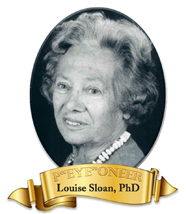
Blazing a Deep Trail: Dr. Louise Sloan
Continuing on with our P”EYE”ONEER series, the spotlight today is on Dr. Louise Sloan.
Gifted in mathematics, Ms. Sloan entered Bryn Mawr College in 1917 where she ultimately earned a PhD in experimental psychology. The majority of her work centered in ophthalmic research.
She began working at the Wilmer Institute in 1929 and for most of her 44-years there directed the Laboratory of Physiological Optics. From 1939 to 1949 she published a 4-part article analyzing the problems of clinical perimetry, and introduced new methods that are now called static perimetry. In 1942, using these perimetric techniques, she did an exhaustive study on retinitis pigmentosa disorder which still stands as an important and ground-breaking work.
During WWII, she took a leave of absence and went to work with the Air Force at the School of Aviation Medicine in San Antonio. Here she began studying color vision and color vision testing, and developed the Sloan Color Threshold Tester and the Farnsworth Lantern Test.
Upon returning to Wilmer, she concentrated on the evaluation of acquired color vision disorders, including congenital achromatopsia and progressive cone degeneration. In 1959 she published a paper describing new acuity charts with a new optotype of 10 sans-serif letters: the Sloan Letters. Up until that point, not only were there a variety of optotypes, luminance levels, contrasts and test distances, but the most-popular Snellen letters and Landolt C’s were found sufficient for screening “within normal limits” but found lacking at the low vision end (20/200 and 20/400).
The Sloan Letters were designated the US standard for acuity testing by the National Academy of Sciences, National Research Council. The bulk of her Low Vision work was done after her 1st retirement in 1963. With her background in psychology, Sloan took the novel approach of listening, watching and attending to the coping of the disability in conjunction with the diagnostics. In a 1978 book review by J. Silver for British Journal of Ophthalmology, of Sloan’s book, “Reading Aids For the Partially Sighted: A Systematic Classification and Procedure for Prescribing”, Silver notes, “Dr. Sloan became one of the great innovators of the American low vision field by the simple expedient of finding out what the patient could cope with and then supplying it, and if no such device existed she persuaded someone to produce it.”
Credits: Colour Vision Deficiencies VII, Robert Mastoff, edited by G. Verriest. Book Reviews, British Journal of Ophthalmology, 1978, 62, 195; Janet Silver.
Have a thought about this article? Contact Us and let us know.